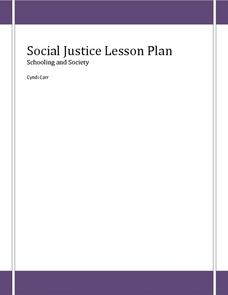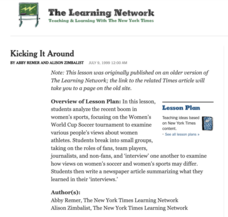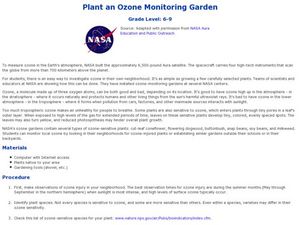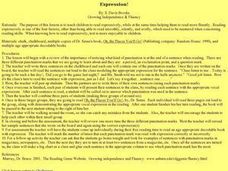Curated OER
Health Issues Related to Space Experiments
Students participate in a science instructional activity that integrates connections between health issues on Earth and how those issues are related to studies conducted on the International Space Station. T
Curated OER
Social Justice-Water in Developing Countries
Young scholars explore how water shortage affects everyday life. In this social justice lesson, students discuss information about water shortage in Ghana. A water shortage simulation/game is played in which a "Canadian" team starts with...
Curated OER
A Day in the Life
Students write an essay. In this comparison lesson, students read about a child's typical day on a fair trade cocoa farm in the Dominican Republic. Students write about a typical morning of a child in the US and make comparisons.
Curated OER
A Plant Begins
Students follow the growth of a plant from seed to adult plant. In this plant lesson, students watch the growth of a plant over time and record the changes to the plant. Students complete worksheets with their observations. Students...
Curated OER
Food Chain: what's for dinner?
Fourth graders identify where foods came from and sequence a food chain. In this food chain lesson, 4th graders define vocabulary related to food chains and order a food chain. Students follow the energy of a food chain. Students...
Curated OER
Kicking It Around
Students analyze the recent boom in women's sports, focusing on the Women's World Cup Soccer tournament to examine various people's views about women athletes. They write a newspaper article summarizing what they learned in their...
Curated OER
Acid Rain
Students understand the dynamics of acid rain and its impact on the living and non-living environment. They hypothesize how acid rain affects water pH levels in two lake systems with differing watershed features.
Curated OER
Compost in a Bag!
Fourth graders experiment to see which objects decompose. In this compost lesson, 4th graders observe the changes of labeled objects in a bag. Leave the objects for one month and record the changes by observation and weight. Students...
Curated OER
Forests Need People
For this forests and people lesson, 3rd graders brainstorm what forests are used for, discuss forest habitats, and how human interventions have affected trees and animals that depend on the forest environment. Students read the books,...
Curated OER
Stem Cells: 5 Year Progress Report
Students explore different aspects of stem cells. In this human biology lesson plan, students complete numerous activities including reading an article and discussing it, watching a video on stem cells reproducing over time, and...
Curated OER
Plant an Ozone Monitoring Garden
Students create a garden. In this ozone lesson, students discuss ozone injury, identify plants sensitive to ozone, and then plant their own ozone garden.
Curated OER
Abolitionists and Proponents of Slavery
Eleventh graders compare and contrast the visions of abolitionists and proponents of slavery. In this slavery lesson, 11th graders read primary documents representing both sides of the slavery issue and use graphic organizers to analyze...
Curated OER
When You Were My Age, What Was This Place Like?
Students discover how land use in their community has changed. In this community and ecology lesson, students scan old newspapers to find articles about the development of community land. Students discuss and predict how land use has...
Curated OER
Immigration, Where Do We Go From Here?
Students describe difference between immigration and emigration, and summarize impact that immigration and emigration have on a community.
Curated OER
Soccer Fever Gets Hot
Students examine rules of soccer, focusing on basic skills necessary to play, create imaginary team, match players with positions that best fit their skill levels and personalities, and practice new skills with classmates.
Curated OER
Time Changes Everything
Students analyze census data from 1915, 1967 and 2006. They read an article about how the world's population is growing at an alarming rate. They use primary source documents to create a timeline on the information they gathered. They...
Curated OER
Privacy in the Age of Video Surveillance: This Is Not Your Father's Candid Camera
Eighth graders examine the use of video surveillance in the corporate world and other life situations. In groups, they determine how many times and in what situations they believe they are being watched. They use the Constitution to...
Curated OER
Expression!
Students organize ways of reading expressively as well as fluently. They encounter books by Dr. Seuss within this lesson plan. Practice, practice and more practice makes perfect. Punctuation marks are reviewed for accuracy.
Curated OER
Tank Trials - Measuring Germination
Students observe and measure seed germination. In this life science lesson, students use 'tanks' to observe a set of seeds as they germinate and begin growing, make predictions, and record their data. Lesson includes background teacher...
Curated OER
Timekeeping by the Sun
Students measure shadows to learn about the Sun-Earth relationship. In this astronomy lesson, students create a shadow stick of a Pokemon character and record measurements of its shadow in a data chart. Follow-up discussions guide...
Curated OER
Three Clouds Activity
Students understand how clouds are formed. In this cloud lesson, students participate in three experiments to make clouds. Students complete activity sheets for each experiment.
Curated OER
This Land Is Our Land
Students explore land use. In this land lesson, students examine the use of land and land records. They create a diagram of a specified piece of land and determine the area of the land. Students discuss their findings.
Curated OER
Mosquito Bytes
Students investigate mosquitoes. In this mosquito bytes lesson, students consider reasons why mosquitoes transfer disease and ways to combat them. Students read an article, discuss, and complete a quiz.
Curated OER
All A-buzz About Math
Second graders participate in Math-Eze activities to comprehend word problems. In this word problem lesson, 2nd graders recognize why a hexagon is the best shape for a beehive. Students calculate how far bees must travel to find 2 lbs....

























